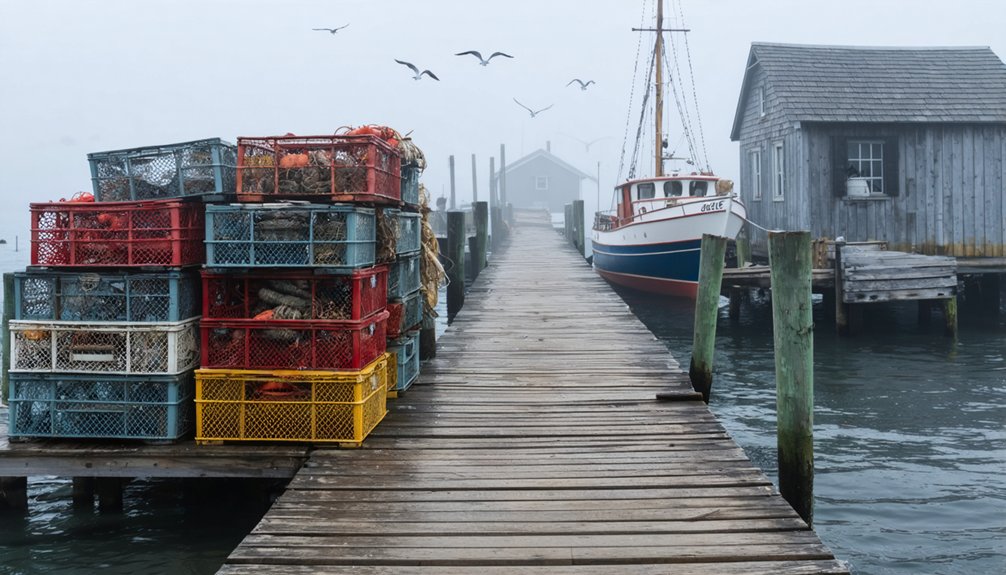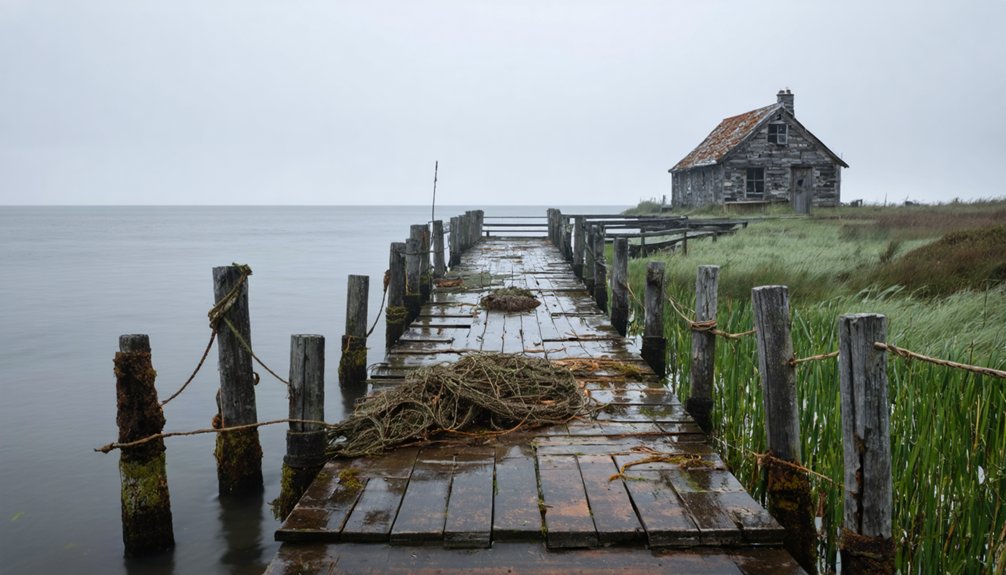America’s most enthralling abandoned fishing villages include Terminal Island, California’s Japanese-American community forcibly dismantled after Pearl Harbor; Stumpy Point, North Carolina’s self-sufficient settlement once known as the “Shad Capital of the World”; and Brown’s Island, Virginia’s transformed industrial site with Civil War origins. You’ll find these forgotten maritime hubs rich with unique dialects, fishing innovations, and cultural resilience. The haunting remains of these coastal communities reveal America’s complex relationship with its seafaring past.
Key Takeaways
- Terminal Island in California featured a thriving 2,000-person Japanese-American fishing community until its forced evacuation after Pearl Harbor.
- Stumpy Point, North Carolina’s “Shad Capital of the World,” once led the state in fish production with three million pounds annually.
- Brown’s Island transformed from a coastal fishing settlement to an industrial site, now serving as Richmond’s premier outdoor venue.
- Preservation efforts including oral histories and cultural celebrations help maintain the legacy of these abandoned villages.
- Each abandoned village showcases unique cultural resilience through maritime traditions, dialect development, and community infrastructure.
Terminal Island: California’s Lost Japanese-American Fishing Community
While now largely forgotten in California’s complex coastal history, Terminal Island once hosted a thriving Japanese-American fishing village established around 1907 as Fish Harbor.
You’ll find the origins trace to Southern Pacific Railroad laborers who pioneered abalone diving in the 1890s before revolutionizing tuna fishing with Japanese heritage techniques.
By the 1930s, this 2,000-person maritime community had created a self-contained world with distinct dialect, traditions, and communal infrastructure—all reflecting their fishing traditions. This vibrant community was integral to California’s fishing industry, supplying much of the region’s seafood.
A cultural island within an island, Terminal Island’s Japanese fishing village breathed with its own rhythms, language, and shared maritime purpose.
Following Pearl Harbor, the community was violently uprooted when residents received 48-hour evacuation orders at gunpoint. The Navy systematically erased the physical village, demolishing homes and confiscating vessels.
Today, only two historic buildings remain as monuments to this once-vibrant culture, with former residents’ organizations preserving oral histories of freedom before their forced displacement. The community maintained strong Japanese identity through traditional foods, homemade sake, and cultural celebrations that distinguished Terminal Island Nisei from other Japanese-American children.
Stumpy Point: North Carolina’s Forgotten Maritime Legacy
Hidden along North Carolina’s eastern shore, Stumpy Point emerged in the late 1700s as a demonstration of maritime isolation and self-sufficiency, with the Midgett family establishing what would become one of America’s most resilient fishing communities.
You’ll find echoes of their fishing heritage in the village’s evolution from agriculture to commercial fishing. Early settlers drained marshlands through hand-dug canals before the community transformed into the “Shad Capital of the World.”
When outsiders threatened local waters with superior equipment and firearms, Stumpy Pointers fought back, eventually securing legislative protection.
Their maritime culture survived through pound nets and buy boats that connected them to mainland markets. These specialized fish buy boats would purchase catches directly from fishing vessels offshore, allowing crews to continue working without interruption.
Though modern shrimping and crabbing operations continue, the village’s isolated character remains largely unchanged—a reflection of over 200 years of nautical tradition preserved through storytelling and stubborn independence. By 1939, the village had become so productive that it led North Carolina in fish production, shipping an impressive three million pounds annually.
Brown’s Island: An Abandoned Coastal Haven Reclaimed by Nature
Despite bearing the name “island,” Brown’s Island in downtown Richmond, Virginia stands as a curious anomaly in our exploration of abandoned coastal fishing villages—for it never hosted a fishing community and lies 100 miles from the Atlantic coastline.
This six-acre artificial landmass, originally a mere sandbar, witnessed the transformation from Civil War munitions facility to industrial powerhouse. After a devastating 1863 explosion killed 45 workers, it evolved into an energy hub with coal and hydroelectric plants until the 1970s’ floods ended its industrial heritage. The island was named after its first settler Elijah Brown, who established residence there in the late 18th century. The island remains accessible to visitors primarily through the Foundry Park Bridge at 5th Street.
You’ll now find this reclaimed space serving as Richmond’s premier outdoor venue. Where factories once hummed, you’ll discover urban reclamation at its finest—concerts, festivals, and interpretive markers telling its complex story.
Wander the Riverfront Canal Walk and contemplate how nature and public vision resurrected this once-abandoned industrial site.
Frequently Asked Questions
Are These Abandoned Fishing Villages Safe to Visit Today?
You’ll find most villages present hazards—deteriorating structures, unstable footing, wildlife. Follow visitor guidelines and safety precautions: wear sturdy boots, respect posted warnings, and consider guided tours for ideal protection.
What Items Can Visitors Legally Collect From These Abandoned Sites?
Keep your hands off the treasure! Legal collection at these sites is virtually nonexistent. Historical artifacts are federally protected, with even shells and driftwood often restricted by local regulations.
How Did Modern Environmental Regulations Impact These Fishing Communities?
You’ll find regulations decimated these communities by restricting traditional sustainability practices through catch limits, gear bans, and season constraints while simultaneously eroding ancestral fishing rights that had sustained maritime livelihoods for generations.
Can Metal Detectors Be Used at These Historical Locations?
You’ll face strict metal detector regulations at most sites. Historic artifact preservation laws require permits on public lands. Violate these maritime restrictions, and you’ll risk hefty fines, equipment confiscation, or even criminal charges.
Do Any Descendants of Original Residents Conduct Tours?
Diving into the currents of time, you’ll find limited descendant involvement in official tours. Occasionally in the Aleutian Islands and El Pardito, descendants weave their ancestral narratives into specialized maritime tour experiences.
References
- https://www.islands.com/1696596/florida-gulf-coast-hides-little-known-serene-cortez-historic-fishing-village-cortez-seafood/
- https://repository.library.noaa.gov/view/noaa/19459/noaa_19459_DS1.pdf
- https://coastalreview.org/2022/01/lost-photographs-remembering-ncs-fishing-communities/
- https://repository.library.noaa.gov/view/noaa/19456/noaa_19456_DS1.pdf
- https://www.startribune.com/tradition-lives-on-in-fishing-village/130372683
- https://www.messynessychic.com/2021/11/23/the-japanese-fishing-village-that-vanished-from-los-angeles/
- https://www.youtube.com/watch?v=1a__qFVnlMg
- https://www.youtube.com/watch?v=ZoX5XrPeYFE
- https://priceschool.usc.edu/news/terminal-island-history-japanese-los-angeles/
- https://asamnews.com/2024/05/07/terminal-island-japanese-culture-dialect-fishing-community-california/



